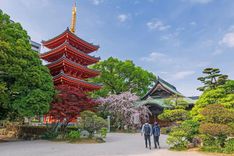- Japan
- Enoshima
The Japanese island of Enoshima is only tiny, but it’s packed with points of interest – from ancient Shinto shrines to modern Buddhist temples, and mysterious cave grottoes to hilltop viewpoints. It’s especially famous as one of the best places in Japan to enjoy beautiful sunset views over iconic Mount Fuji. The island can be reached by train from Shinjuku, Tokyo in under one hour, with travel covered by the economical Enoshima-Kamakura Freepass. Keep reading for our top things to do on Enoshima Island.

Enoshima Island © Odakyu Group
1. Catch Mount Fuji at sunset
Mount Fuji is beautiful at any time of day — its perfectly symmetrical cone is one of the most iconic images of Japan. But at dusk, with its snow-covered peak glowing in the setting sun across Sagami Bay, it’s a true showstopper. Among the many islands in Japan, Enoshima stands out for its sunset views, especially of Fuji. One of the best spots on the island to take it all in is the Enoshima Sea Candle. This lighthouse rises 351ft (107m) above sea level and offers sweeping views from both indoor and outdoor observation decks.
If you haven’t got a head for heights, that doesn’t mean you need to miss out on Enoshima’s gorgeous sunset views. In fact, the best place to watch dusk over Fuji is down by the shoreline, at Chigogafuchi Abyss on the island’s west coast. This is considered the most photogenic spot on the island, a plateau of flat rock jutting out into the sea which affords great views out to Mount Fuji.
For an extra spectacular Fuji sunset, visit Enoshima during early April or early September to witness a phenomenon known as “Diamond Fuji” – the setting sun lines up perfectly with the peak of the mountain, scattering the light like a precious stone.
This is just one of the reasons Enoshima is among the best islands to visit in Japan.

Mount Fuji and Enoshima Island at sunset © Sakarin Sawasdinaka/Shutterstock
2. Explore the mysterious Enoshima Iwaya Caves
On the southern coast of Enoshima Island lie two atmospheric caverns known as the Enoshima Iwaya Caves. To reach them, you need to head to the top of the island – either up a series of stairs or by escalator. To get to the entrance of the caves from the top, it’s a steep walk down some cliffside steps for around 20 minutes. Once you’re there, you’re given a candle to light your way in the darker corners and sent off to explore the caves yourself.
The first chamber contains beautifully rendered statues of the Buddha, reflecting the cave’s association with En no Ozunu. This 7th-century ascetic monk was the originator of Shugendo, a Japanese religious tradition which blends elements of Shinto, Buddhism and Taoism. In the centuries since, scores of Buddhist monks undertook training in this cave, which became a popular pilgrimage site in the samurai era.
Keep walking to reach the second cave, where you’ll be greeted by a dramatically lit dragon statue.

Looking out from Enoshima Iwaya Caves © Shutterstock
3. Check out the Love Bell
One of the more charming things to do on Enoshima is to visit the Love Bell, perched on a hill east of the Enoshima Iwaya Caves. Couples make the short climb to the bell, ring it while making wishes for their future, and then, in a ritual straight out of a Paris daydream, attach padlocks adorned with romantic messages to a fence overlooking the sea.
4. Visit Enoshima’s sacred shrines
The protective goddess of Benzaiten – a Japanese version of Saraswati, the Hindu goddess of wisdom and art – is commemorated at three shrines across the island. The main shrine complex can be found surrounded by forest on a hill in the middle of the island. It includes a building called Hoanden, an octagonal hall topped with a pavilion roof and painted a striking shade of vermilion.
Inside are some of the most sacred Benzaiten statues in Japan. Benzaiten – or Benten, as she’s known for short – is also the goddess of the sea and water, as well as inviting happiness and treasure, so it’s not uncommon to see visitors washing their money in a pond at the shrine.

Bronze Torii Gate © Odakyu Group
5. Discover Enoshima’s modern Buddhist temple
Despite Benten’s Hindu origins, she has a dual role in Japan: as a Shinto deity, or kami, and a Buddhist goddess. This reflects the nature of religion in Japan, where the majority of the population combine aspects of Shinto and Buddhist practice, visiting both shrines and temples. During the Meiji period from 1868–1912, however, the government adopted a strong anti-Buddhist stance, and attempted to eradicate it from the country and adopt Shinto as the state religion.
As a result, Enoshima’s three Buddhist temples were destroyed during this period. A new Buddhist temple, Enoshima Daishi, was finally built in 1993. You’ll find it just five minutes’ walk south of the main Shinto shrine complex. With a cylindrical central chamber and supported by Greek-style columns, it’s very different from the ancient shrines and temples you’ll see across Enoshima and the rest of Japan, but no less atmospheric.
6. Take a stroll through the Enoshima Samuel Cocking Garden
British merchant Samuel Cocking arrived in Japan in 1869, not long after the Edo Period ended and Japan re-opened to the outside world after centuries of isolation. After Enoshima’s Buddhist temples were destroyed in the following decades, Cocking purchased the land on which they sat in 1885 and established the green houses and large garden. Today, this botanical garden is home to some 10,000 plants from across the South Pacific, and makes up a beautiful garden which surrounds the landmark Enoshima Sea Candle – the perfect place to rest after walking up the hill to the shrines.

Looking out from the Enoshima Sea Candle © Odakyu Group
Other things to do in Enoshima
If the mere thought of visiting all Enoshima’s attractions on foot is tiring you out, don’t worry — the Enoshima Escar gets you to the hilltop shrines in under five minutes. Still need a breather? Head to the Enoshima Island Spa on the north coast, where natural hot spring baths overlook Sagami Bay and Mount Fuji.
And while you’re on Enoshima Island, don’t skip the local specialty, shirasudon — tiny whitebait fish served raw or cooked over rice, found in restaurants all over the island. It’s the kind of experience that makes Enoshima a perfect stop on any 10-day itinerary in Japan, especially if you're chasing coastal views, culture, and great food in one go.
Continue your exploration of Japan with our practical tips on what you need to know before travelling to Japan.
Header image: sunset over Enoshima Island © Karen Colon/Shutterstock












